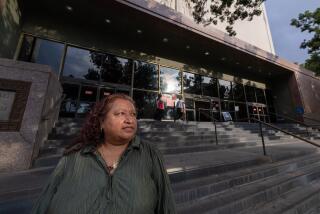Initiated as Cost-Cutting Measure : Civilian Bailiffs Establish Their Place in Courtroom
When civilian court attendants first called Los Angeles Superior Court civil trials to order five years ago, they had one edict from the Board of Supervisors: Cut costs.
That was easy.
But they got a second mandate from their boss, Myrna-Joy Pugh, and Frank Zolin, Superior Court clerk-executive officer, that was somewhat unusual for government programs under post-Proposition 13 cutbacks: Maintain the same level of service.
That was harder.
The court attendant program, patterned after a similar program in Santa Clara County that was first advocated here by Supervisor Edmund G. Edelman, substitutes less skilled, less thoroughly trained and less expensive civilians for deputy sheriffs as bailiffs in certain courtrooms.
âEd Edelman had a good idea, and a majority of the judges supported it,â Zolin said after the programâs thorny five-year maturation. âIt has been a beneficial program for the taxpayers without any loss of service.â
With a fairly stable corps of more than 30 court attendants assisting 39 deputy sheriffs in the downtown Los Angeles County Courthouse, Zolin estimated that the county has saved nearly $2.5 million in salaries and fringe benefits since the program was initiated.
Deputy sheriffs who work as bailiffs earn between $2,002 and $2,361 a month. The civilians earn from $1,491 to $1,857.
Besides calling courts to order, court bailiffs shepherd juries, help lawyers set up exhibits, run official errands for judges and--most important--provide security.
The civilians--who wear navy blue blazers, tan shirts and tan skirts or slacks--initially encountered resistance from judges, court clerks and others who doubted that they could do any of those things.
âWe were the new kid on the block,â said Pugh, 49, a county management employee for 22 years with a masterâs degree in administration but no law enforcement background. âCredibility was something we had to earn. It was not given easily.â
Pugh and Zolin required potential court attendants to have four years of college or work experience in a court-related job or a combination of the two. They set up a rigid two-week training program covering courtroom procedures, earthquake and fire preparedness, stress management and first aid, including cardiopulmonary resuscitation.
They made some mistakes during the initial shakedown period. Some of the first attendants did not work out in the courtroom and had to be replaced. A pooling program under which one attendant served two or more courtrooms, often different ones each day, had to be scrapped.
Under Continuing Scrutiny
Despite its problems, the program survived its six-month experimental start and has been funded from year to year under continuing scrutiny by the Superior Court judgesâ Personnel and Budget Committee. Judges, in periodic questionnaires, have rated the program âexcellent,â with no recommendations for change.
Ranging in age from mid-20s to mid-60s, the court attendants include several law students, former clerical workers and security guards and grandmothers in second careers.
For Randy McMurray, 31, a political science graduate who had been a county maintenance worker and security guard, the job was a way to find out whether he would feel comfortable enough in courtrooms to go to law school. He did and is now in his third year of night classes at Southwestern University.
Job Is âthe Greatestâ
For Beverly Holcomb, 54, a graduate in behavioral science who has been a county welfare eligibility worker, the job is âthe greatestâ way to work with the public and to learn new things to discuss with her 10 grandchildren.
âThe courtroom is like a classroom sometimes,â she said enthusiastically after five years on the job. âYou learn a lot.â
Court attendants quickly proved their ability to handle juries and routine emergencies.
Praising court attendants for their âsensitive, careful handlingâ of juries, Judge Ronald E. Swearinger said one juror recently complained that an attendant had indicated through body language that deliberations were taking too long but that jurors more frequently send attendants flowers and notes of thanks.
Several attendants have been credited with aiding jurors, witnesses or litigants stricken by heart attacks or fainting spells. Pugh said she thought that it was a badge of acceptance about a year after the program began when two deputy sheriffs asked court attendant McMurray for help with an aged man who suffered a heart attack outside a probate courtroom. It was the civilian who provided mouth-to-mouth resuscitation.
Found No Resistance
Court attendants say they expected the most resistance from the deputy sheriffs serving as bailiffs, but they found none.
âThey were happy to see us. They hadnât been able to staff a lot of courtrooms and were getting criticism,â McMurray said. âNow we have a mutual dependence. We depend on them for all the security in the building, and they kind of depend on us to keep the judges happy.â
âWe are a very efficient and cohesive team,â said Lt. Spike Dammer, acting captain of the Sheriffâs Court Services West Bureau.
But nobody--least of all themselves--equates court attendants with sworn peace officers.
âWe try to develop a command presence,â Pugh said, âso that people see not a âcivilian bailiffâ but just a bailiff who is in charge. Many situations can be controlled by command presence.â
When that fails, the court attendants, like all civilians, call a cop. Or, rather, two deputy sheriffs.
Civil Trials Safer
In setting up the cost-cutting court attendant program, Zolin was adamant that the civilians should serve only in civil trial courtrooms, where incidents of violence are least likely. The arrangement called for deputy sheriffs to be stationed in two courtrooms on each floor.
âThe system is designed so that deputies will arrive at the scene of any problem situation very, very quickly,â said Swearinger, who has monitored the program for the courtâs Security Committee. âI have tested that system from time to time, and I have a bailiff in here in less than two minutes.
âThere is a certain comfort in having a sworn peace officer with a gun. But to be cost-efficient, we have to give up our prerogatives.â
âAs far as security, that escape hatch is always there,â said Judge Jack W. Swink, alluding to buttons installed in judicial benches that summon deputy sheriffs. âYou can always hit the button and get under the desk.â
Bailiff Always There
Some judges, like Charles H. Older, who presided over the Charles Manson murder trial 15 years ago and has received death threats from Manson followers, will always have a deputy sheriff as his bailiff, Zolin said.
Despite requests by some branch court judges, Zolin has resisted expanding the program because of security concerns. In smaller courthouses, he said, the civilians might have to substitute for absent deputy sheriffs in criminal, juvenile or family law departments, which he believes would be unsafe.
âOur people do an excellent job in civil trial courts where incidents are few,â he said. âI do not believe our staff is qualified to handle felony defendants or other situations where violence is involved.â
Pugh agrees. Acknowledging that they cannot provide the total security expected of an armed peace officer, Pugh still believes that the court attendants have met their mandates to serve the courts adequately while saving taxpayersâ money.
âIf we were not responsive to the court needs,â she said, âwe wouldnât still be here.â
More to Read
Sign up for Essential California
The most important California stories and recommendations in your inbox every morning.
You may occasionally receive promotional content from the Los Angeles Times.










